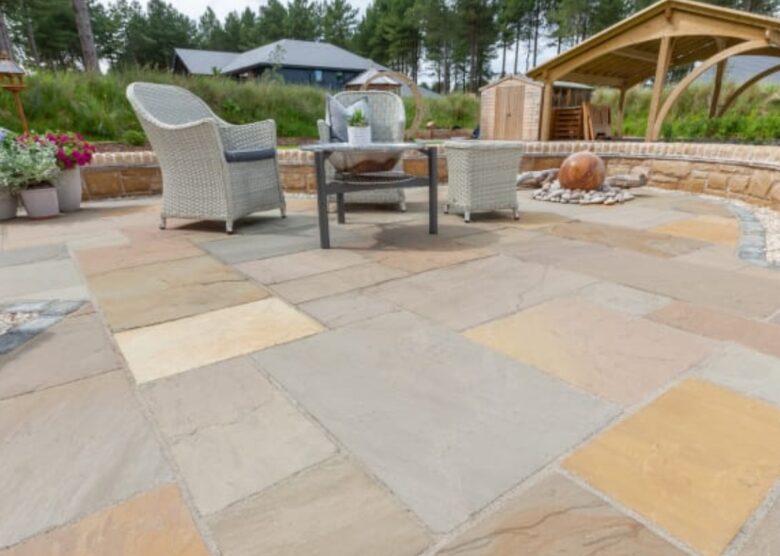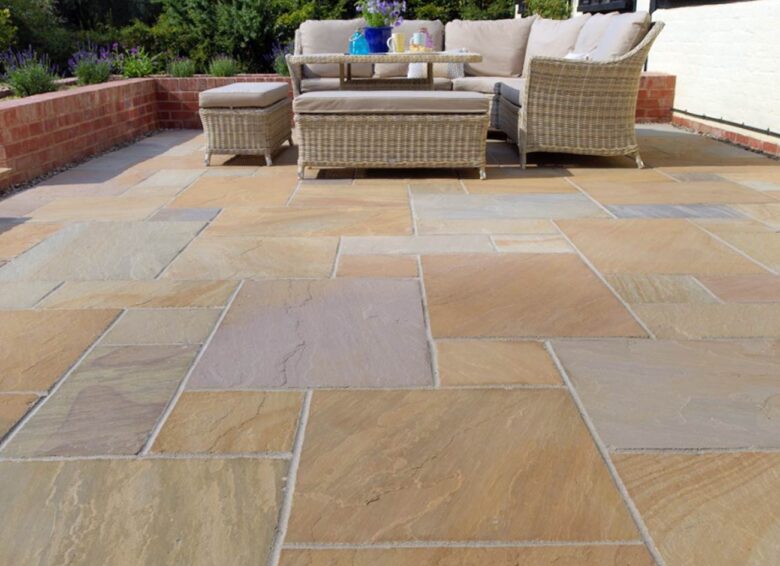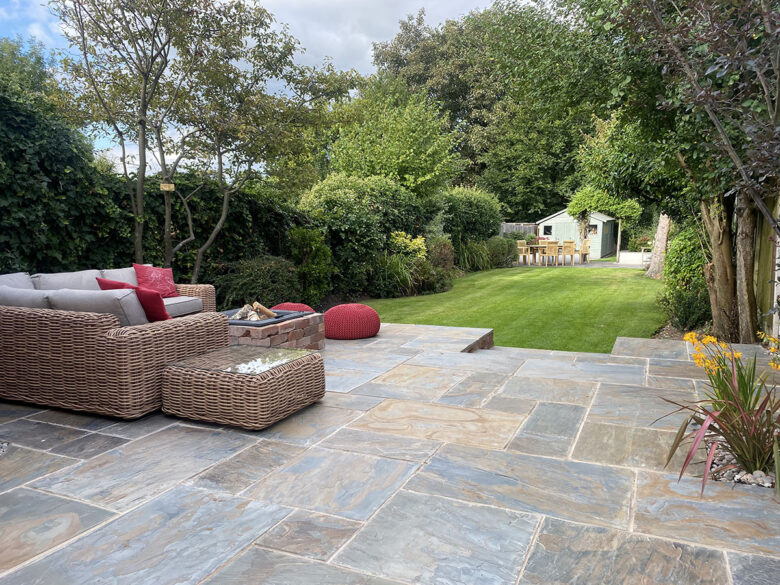Installing a new sandstone patio can be a significant investment that you want to protect. But does the beautiful natural stone require sealing? This comprehensive guide answers all your questions on the necessity, benefits, application methods, and maintenance considerations for sealing sandstone patio pavers.
Contents
- Should I Seal My New Sandstone Patio?
- What Type of Sealer Does Sandstone Patio Paving Need?
- When Should I Seal My Sandstone Patio?
- How Do I Apply Sandstone Sealer Properly?
- How Often Should I Re-seal My Sandstone Patio?
- Does porcelain patio paving need sealing?
- What is the best sealer for sandstone?
- How long does sandstone sealer last?
- Can you use brick sealer on sandstone?
- How do you restore faded sandstone?
- Will sealer prevent weeds coming through sandstone?
- Can you seal wet sandstone?
- Choosing the Right Sandstone Patio Sealer
- Sealer Lifespan on Sandstone Patio Paving
- Masonry Sealers vs Sandstone Sealers
- Reviving Faded Sandstone Paving
- In Conclusion
Should I Seal My New Sandstone Patio?
Sealing sandstone patio pavers is optional, not an absolute requirement. While innately durable, sealing provides two potential benefits – limiting stain absorption due to porosity and enriching natural colors. If you wish to protect against moisture damage or enhance stone appearance, a penetrating sealer is recommended. But unsealed sandstone can still endure outdoors reasonably well with proper installation.
However, there are two vulnerabilities that make sealing worthwhile for many sandstone patio owners:
1) Porosity – Sandstone’s granular mineral composition gives it a porous, permeable texture that allows spill penetration leading to difficult staining over time. Sealing creates a protective barrier limiting this absorption.
2) Enriching Appearance – While optional, sealing enhances the vibrant colors, contrasts, and textural depth within the stone. So sealing delivers not just practical protection, but aesthetic enrichment.

Source: marshalls.co.uk
What Type of Sealer Does Sandstone Patio Paving Need?
Penetrating vs Surface Sealers
The two main categories of sealers are:
Penetrating sealers – Absorb below the surface to provide invisible moisture protection without altering appearance
Surface sealers – Form a protective coat on top of the stone which can enhance color and sheen
For patio usage, penetrating sealers are overwhelmingly recommended as they don’t change the natural sandstone’s look. Surface sealers often create a “wet” high-gloss that looks artificial on textured slate or tumbled pavers meant to mimic nature.
When Should I Seal My Sandstone Patio?
For newly installed sandstone, allow sufficient drying time before sealing to prevent trapping residual moisture. Ambient temperature, humidity, and exposure to direct rain or sunlight impact dry times. But expect to wait roughly 72 hours in typical weather before the stone is adequately cured and dry enough to accept a protective sealer application without risk of water entrapment damage. Always test thickness before fully sealing.

Source: nustone.co.uk
How Do I Apply Sandstone Sealer Properly?
With the pavers clean, dry, and fully cured, follow these steps for successful sandstone sealing:
1) Prepare sealer according to manufacturer instructions
2) Apply using brush, sprayer, or roller in thin, even coat
3) Enable 15-20 minutes of absorption time
4) Gently wipe away any excess pooling sealer on surface
5) Allow 6 hours minimum for full curing before contact
6) Perform second coat if necessary for desired coverage
How Often Should I Re-seal My Sandstone Patio?
In general, expect to re-apply sealant every 2-4 years depending on traffic intensity. But evaluate condition annually and re-seal at first signs of diminished water beading effect or return of staining. Harsh winters and ultraviolet summer sunlight degrade sealants over time. Catching depletion early ensures ongoing stain protection.
While porous sandstone can stand on its own without sealing, treating it pays practical protective and aesthetic dividends in many patio settings. Take climate conditions, usage demands, and re-application commitments into account when deciding on sealants. And properly prepare and apply them for optimal results.
Consult stone and landscaping specialists if unsure about products and procedures for your unique project. But armed with this general guidance, sealing sandstone yourself can be straightforward and rewarding.

Source: pinterest.com
Does porcelain patio paving need sealing?
No, porcelain pavers do not require sealing due to being non-porous and stain resistant already.
What is the best sealer for sandstone?
Penetrating silicone sealers can be purchased from Paving Shopper and work well to protect sandstone patio pavers while retaining the natural appearance. Brands like Dry Treat and Lithofin are top options.
How long does sandstone sealer last?
Expect sandstone patio sealer to last 2-4 years typically before needing reapplication, depending on weather exposure and traffic.
Can you use brick sealer on sandstone?
No, do not use masonry or brick sealers on natural stone. Always select an appropriate sandstone-specific sealing product.
How do you restore faded sandstone?
Use poultice cleaners to deep clean and rejuvenate discolored or faded sandstone. Follow up with an enhancing sealer that intensifies hues and color depth.
Will sealer prevent weeds coming through sandstone?
No sealer cannot prevent weed growth entirely. But sealing helps limit organic material and moisture getting between pavers needed for germination. However it will prevent the slabs from cracking.
Can you seal wet sandstone?
You should always allow 72 hours minimum for full drying before attempting to apply any protective sealant onto sandstone.

Source: pavingdirect.com
Choosing the Right Sandstone Patio Sealer
When sealing your sandstone patio, it’s crucial to pick the right sealer. For the best results, opt for a penetrating silicone sealer, which is proficient at protecting the pavers while maintaining the stone’s natural appearance. Top brands such as Dry Treat and Lithofin offer robust options that homeowners can depend on.
Sealer Lifespan on Sandstone Patio Paving
For homeowners wondering how long they can expect their sealant to last, a sandstone patio sealer typically remains effective for 2-4 years before necessitating reapplication. However, this can be influenced by factors like weather exposure and foot traffic. Regularly assessing the sealer’s condition can help maintain its effectiveness.
Masonry Sealers vs Sandstone Sealers
Although the idea of utilizing masonry or brick sealers on natural stone may seem appealing to some homeowners, it’s a big no-no. Sandstone and other natural stones have specific sealing requirements, making it crucial to always opt for a sandstone-specific product to ensure effective protection.
Reviving Faded Sandstone Paving
Faded or discolored sandstone can detract from your patio’s overall aesthetic. But fret not – the appearance of your sandstone can often be rejuvenated using poultice cleaners. They’re an excellent choice for deep cleaning, and a follow-up with an enhancing sealer can intensify the hues and depth of your stone’s color.

Source: nustone.co.uk
In Conclusion
Sealing sandstone patios, while not obligatory, offers both practical protection and aesthetic enhancement. Choosing a suitable sealer, understanding its lifespan, and knowing your sealing requirements are essential for effective preservation. Moreover, sealing can assist with weed prevention and revive faded sandstone. Therefore, sealing is a worthwhile consideration for maximizing your patio’s longevity and allure.
